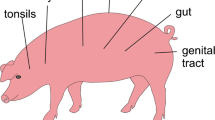Abstract
Dexamethasone administration has been widely used as a model of immunosuppression in various species. The objective of the work reported here was to evaluate immune function in pigs treated with dexamethasone. Experiment 1 pigs were assigned to either control (n = 10) or 2 mg/kg dexamethasone (n = 10) treated groups. Treatments were administered 48 and 24 h before immune function testing. The dexamethasone-treated pigs received the drug on 22 of 72 experimental days. Pigs in experiment 2 were assigned to one of three groups: control (n = 10), 2 mg/kg dexamethasone (n = 10), or 6 mg/kg dexamethasone (n = 10). Treatments were given once and immune functions were evaluated 3 and 27 h after treatment. Lymphocyte blastogenesis, total and differential white blood cell count, and several measures of in vitro neutrophil function were measured in both experiments. Antigen specific antibody production, growth rate, and organ weights at necropsy were also measured in experiment 1. There were no consistent changes in neutrophil functions in these experiments. Lymphocyte blastogenesis to concanavalin A and pokeweed mitogen was significantly (p <0.05) enhanced during experiment 1 in dexamethasone-treated pigs; antigen specific antibody production was not altered by treatment. Dexamethasone treatment (both 2 and 6 mg/kg) in experiment 2 caused a profound (p <0.02−0.01) decrease in lymphocyte blastogenesis to all three mitogens tested at 3 h after treatment. Lymphocyte proliferation returned to control levels by 27 h after treatment in experiment 2. Dexamethasone treatment was also associated with a relative neutrophilia and lymphopenia in both experiments. Dexamethasone-treated pigs in experiment 1 grew slower, had larger livers and kidneys , but smaller spleens than control animals. The transient decrease in lymphocyte blastoenesis lack of consistent , changes in neutrophil function, and unaltered antibody production despite treatment with large doses of dexamethasone indicate that pigs are remarkably resistant to immunosuppression by this drug.
Similar content being viewed by others
References
Chapple RP, Cuaron JA, Easter RA (1989a) Effect of glucocorticoids and limiting nursing on the carbohydrate digestive capacity and growth rate of piglets. J Anim Sci 67:2956–2973
Chapple RP, Cuaron JA, Easter RA (1989b) Response of digestive carbohydrases and growth to graded doses and administration frequency of hydrocortisone and adrenocorticotropic hormone in nursing piglets. J Anim Sci 67:2974–2984
Feldman EC (1989) Adrenal gland disease. In: Ettinger SJ, Dyson J (eds) Textbook of veterinary internal medicine. W.B. Saunders, Philadelphia, pp 1721–1774
Frey BM, Sieber M, Mettler D et al. (1988) Marked interspecies differences between human and pigs in cyclosporine and prednisolone disposition. Drug Metab Dispos 16:285–289
Goff BL, Flaming KP, Frank DE et al. (1991) Recombinant porcine somatotropin: an immunotoxicology study. J Anim Sci 69:4523–4537
Haynes RC Jr (1990) Adrenocorticotropic hormone; adrenocortical steroids and their synthetic analogs; inhibitors of the synthesis and actions of adrenocortical hormones. In: Gilman AG, Rall TW, Nies AS et al. (eds) The pharmacological basis of therapeutics. Pergamon Press, Elmsford, NY, pp 1431–1462
Huether MJ, Lin G, Smith DM et al. (1993) Cloning, sequencing and regulation of an mRNA encoding procine interleukin-1 beta. Gene 129:285–289
Kaeberle ML, Roth JA (1984) Effects of thiabendazole on dexamethasone-induced suppression of lymphocyte and neutrophil function in cattle. Immunopharmacology 8:129–136
Mann D, Hargis JW (1985) Intradermal testing of swine to monitor changes in delayed hyprsensitivity response. Am J Vet Res 46:2363–2365
Mengeling WL (1989) Latent infection and subsequent reactivation of pseudorabies virus in swine exposed to pseudorabies virus while nursing immune dams. Am J Vet Res 50:1658–1666
Meyer DJ, Coles EH, Rich LJ (1992) Veterinary laboratory medicine interpretation and diagnosis, W.B. Saunders, Philadelphia, 32 pp
Mormede P, More J (1980) Activite pharmacologique comparée de differents esters de la dexamethasone chez le porc. Ann Rech Vet 11:157–164
Plumb DC (1991) Veterinary drug handbook, 2nd edn. Pharma Vet Publishing, White Bear Lake, MN, 326 pp
Pruett JH, Fisher WF, Deloach JR (1987) Effects of dexamethasone on selected parameters of the bovine immune system. Vet Res Commun 11:305–323
Roth JA, Kaeberle ML (1981) Effects of in vivo dexamethasone administration on in vitro bovine polymorphonuclear leukocyte function. Infect Immun 33:434–441
Roth JA, Kaeberle ML (1982) Effects of glucocorticoids on the bovine immune system. J Am Vet Med Assoc 180:894–901
Roth JA, Kaeberle ML, Hubbard RD (1984) Attempts to use thiabendazole to improve the immune response in dexamethasone-treated or stressed cattle. Immunopharmacology 8:121–128
Saulnier D, Martinod S, Charley B (1991) Immunomodulatory effects in vivo of recombinant porcine interferon gamma on leukocyte functions of immunosuppressed pigs. Ann Rech Vet 22:1–9
Schoenbaum MA, Beran GW, Murphy DP (1990) Pseudorabies virus latency and reactivation in vaccinated swine. Am J Vet Res 51:334–338
Thawley DG, Solorzano RF, Johnson ME (1984) Confirmation of pseudorabies [Aujeszky's] virus infection, using virus recrudescence by dexamethasone treatment and in vitro lymphocyte stimulation. Am J Vet Res 45:981–983
Westly H, Kelley K (1984) Physiologic concentrations of cortisol suppress cell-mediated immune events in the domestic pig. Proc Soc Exp Biol Med 177:156–164
Wittmann G, Ohlinger V, Rziha HJ (1983) Occurrence and reactivation of latent Aujeszky's disease virus following challenge in previously vaccinated pigs. Arch Virol 75:29–41
Author information
Authors and Affiliations
Rights and permissions
About this article
Cite this article
Flaming, K.P., Goff, B.L., Frank, D.E. et al. Pigs are relatively resistant to dexamethasone induced immunosuppression. Comp Haematol Int 4, 218–225 (1994). https://doi.org/10.1007/BF00185177
Issue Date:
DOI: https://doi.org/10.1007/BF00185177



